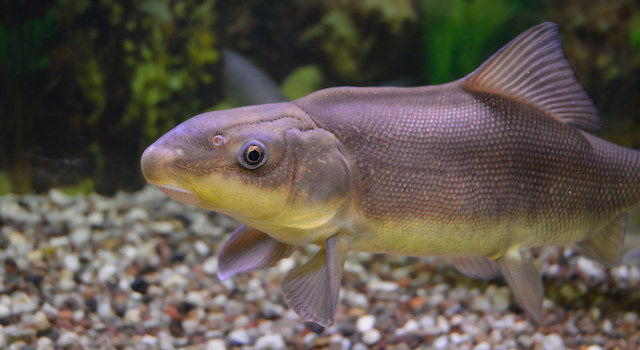Some information may be outdated.
The endangered razorback sucker fish is considered a “true Moab local” that was once on the brink of extinction. But thanks to a collaborative project between The Nature Conservancy and the Utah Division of Wildlife Resources (DWR), the species may be making a comeback.
Three years ago, DWR fish biologists noted an unexpected resurgence of razorback sucker larvae along the shores of the Scott M. Matheson Wetlands Preserve. The chances of the larvae surviving into adulthood, however, have diminished due to decreased habitat caused by changes in the Colorado River.
For that reason, The Nature Conservancy and the Division of Wildlife Resources, co-managers of the wetlands, are partnering in building a fish nursery at the preserve that will provide a safe haven for the fish larvae to grow to a sufficient size to withstand nonnative fish predators in the river.
“The species has been living in the Colorado River near Moab and around the basin for the past three to five million years,” said Katie Creighton, Native Aquatics Project Leader for the Utah Division of Wildlife Resources, in an email to the Moab Sun News. “There’s no arguing that the razorback sucker is a true Moab local.”
The razorback sucker, with its ridged back and floppy lips, evolved specifically to thrive in the desert Southwest’s turbulent brown waters, Creighton said.
Over time, development, industry and agricultural practices have altered the flow of the Colorado River, which has decreased the availability of slow-moving, back-eddy fish habitat for the larvae to grow, safe from predators. The proliferation of nonnative tamarisk trees along the riverbanks has also contributed to fish habitat loss.
“Tamarisks grow so densely along the riverfront – it acts like a sieve,” said Linda Whitham, Central Canyonlands Program Manager for The Nature Conservancy in Utah and manager of the Matheson Preserve. “The sediment gets stuck in the tamarisk trees, preventing channels from doing (their) natural meandering. If we can restore the landscape, it can benefit fish.”
Spawning occurs in the river during the springtime when water is running high and fast. Historically, during this high-water period, larvae drifted from the spawning area, and entered the backwaters where they were protected and grew into young fish. With the loss of wetlands, these fish populations have declined.
The razorback sucker exists only in the Colorado River Basin, and if it becomes lost to extinction, there will be a ripple effect on other native species, Whitham noted.
“One of the things that resonates with me is how certain species, like fish, indicate the health of the river system,” she said.
The Endangered Fish of the Colorado River Basin Recovery Program approached the Conservancy about building a fish nursery in the Matheson Preserve 20 years ago when the property was first purchased, Whitham said. Two years ago, the Conservancy and the DWR began revisiting the issue after discovering a resurgence of razorback larvae in the area.
The fish recovery program started stocking the river with razorback suckers during the 1990s, after a steep decline in the fish population. Natural breeding, however, is needed for the fish population to survive, Whitham said.
While the recovery program has succeeded in increasing the number of larvae in recent years, it is still rare to see young, wild razorback suckers, said Creighton. That’s where this project comes in, she said.
After conducting a feasibility study, Whitham hired an engineering firm to create a design plan which was completed in the spring of 2017. The Nature Conservancy is currently in the process of acquiring the needed permits from the U.S. Army Corps of Engineers before it can proceed with construction of the fish nursery.
Whitham said she hopes to begin construction by late fall, after the migratory bird season.
The project will restore connection between the Colorado River and the preserve by renovating a canal to create a large channel from the river to the preserve’s central pond. This will allow more water to carry larvae into the preserve during the spring runoff. The nursery will provide warm, shallow water for the razorback sucker larvae to grow and thrive before being released back into the river.
The fish nursery will maintain that water throughout the summer, and then allow for drainage in the fall when the larvae have matured into young fish. A screen system will prevent large, nonnative fish from entering the preserve.
“This year we’ll do phase one,” which includes deepening the pond and widening the channel, Whitham said. “We’ll test drive it next spring to see if we’re getting fish coming into the preserve; it’s a two- to three-year project.”
A similar project is taking place on the Green River, outside Vernal. A new fish nursery at the Matheson Preserve would be the first of its kind along the Colorado River in Utah.
“The reason Matheson Preserve is a prime location for this fish nursery is that it’s the only major wetland along the Colorado River in Utah,” said Daniel Eddington, habitat conservation coordinator for the Utah Division of Wildlife Resources.
Other species will also benefit, Eddington said. Waterfowl species, shore birds, migratory birds that visit the wetlands, turkeys, mammals and the northern leopard frog may all benefit from restoring the habitat, he noted. So might other endangered or sensitive fish species, such as the bonytail chub, bluehead sucker and the flannelmouth sucker.
“It’s an amazing wetland there,” Eddington said. “We’re trying to reconnect the Colorado River with the wetland – and at the same time, help fish.”
More water coming into the preserve will also reduce wildfire potential, Whitham said. Several catastrophic wildfires have occurred at the preserve in recent years.
Whitham and her staff have been busy writing grant proposals. They are also looking for private donations. The project is estimated to cost approximately $1 million. The Nature Conservancy is providing matching funds for all state and federal monies raised toward the project.
“In addition to the ecological implications of losing native species biodiversity, losing this species would mean losing some of the uniqueness that makes the region so remarkable and treasured,” Creighton said. “This project is one of the tangible management actions that we can do to help recovery of the razorback sucker, given the demands on water resources will likely continue, if not increase.”
Wetlands managers to build fish nursery to help razorback sucker
Appreciate the coverage? Help keep local news alive.
Chip in to support the Moab Sun News.





